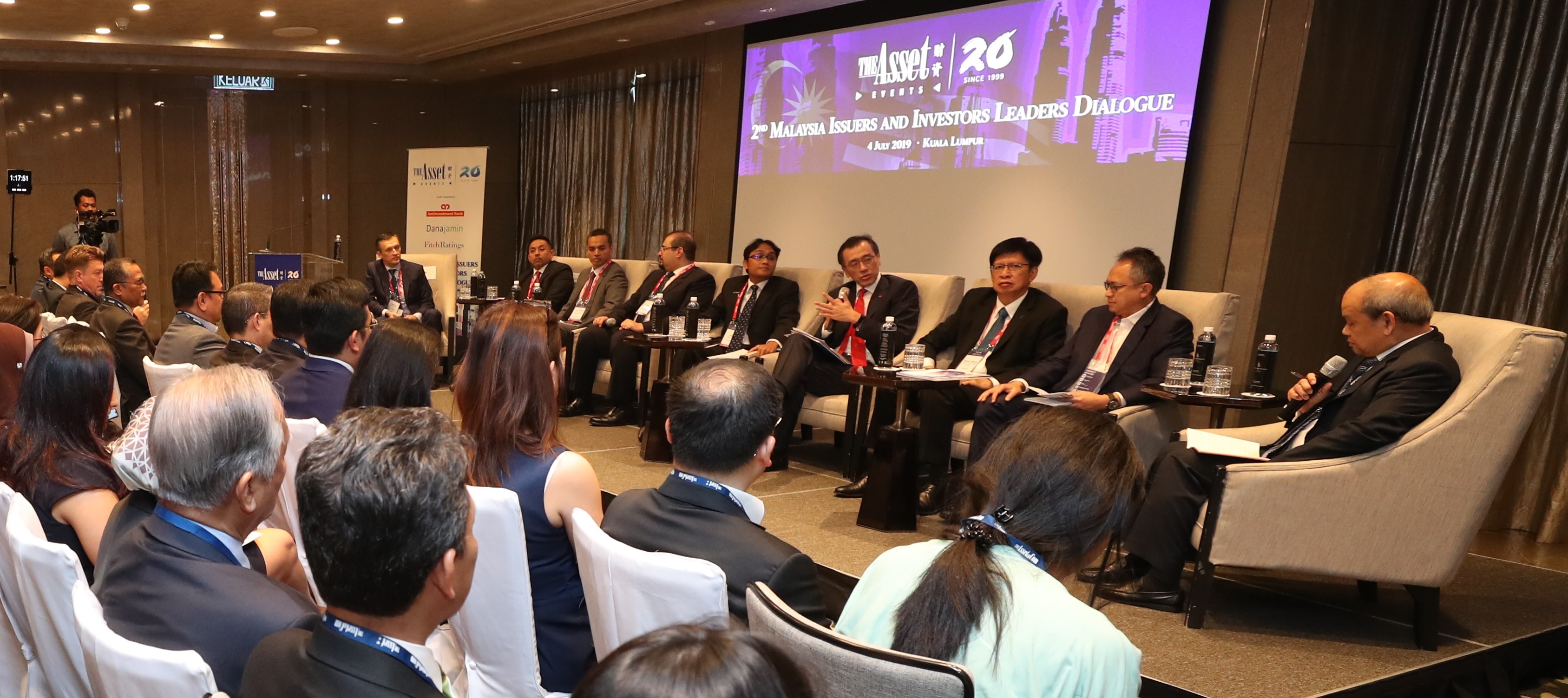
Speakers:
Seohan Soo
chief executive officer, AmInvestment Bank
Amri Sofian
chief corporate and investment officer, Danajamin Nasional
Bashar Al Natoor
global head of Islamic finance, Fitch Ratings
Datuk Chung Chee Leong
president/chief executive officer, Cagamas
Mohamad Damshal Awang Damit
head of equity and fixed income, Pertubuhan Keselamatan Sosial (PERKESO)
Dato’ Paduka Syed Mashafuddin Syed Badarudin
chief executive officer, Principal Islamic Asset Management
Dato’ Chairil Nazri Ahmad
director, energy division, UiTM Energy & Facilities
Andrey Fomin
chief investment officer, Zurich Malaysia
Moderators:
Daniel Yu
editor-in-chief, The Asset
Chito Santiago
managing editor, The Asset
Malaysia’s capital markets may have experienced a bumpy ride in the first half of 2019, characterized by large outflows in both the equity and debt capital markets, but there are expectations the situation will be better in the second half.
Seohan Soo, CEO of AmInvestment Bank, says the Malaysian equity market was down 21% in terms of volume in the first half of 2019, compared to the same period last year, with an outflow of 15 billion ringgit (US$3.56 billion) since last year. It was even more challenging for the bond market, which saw an outflow of 23.2 billion ringgit during the 18 months leading up to the first half of 2019 driven by macro factors, including the interest rate outlook.
The bond outflow was also underpinned by the decision of FTSE Russell, which announced in April that it would review Malaysia’s government bonds’ inclusion in the World Government Bond Index (WGBI). Citing concerns about market liquidity, FTSE Russell placed Malaysia on its fixed income watch list for six months until September this year. (Editor’s note: Malaysia avoided eviction from the FTSE Russell’s WGBI and was given another six months to improve liquidity. FTSE Russell will provide another update after an interim review in March 2020.)
Another development that impacted the bond market after the general elections in May 2018 were the new government’s efforts to pare down government debt, which include stringent timely issuances of government-guaranteed bonds/sukuk being put in place. Hence, there were fewer issuances of government-guaranteed bonds/sukuk in 2018 compared to 2017.
The equity market, meanwhile, is shifting to cash because the current P/E valuation of 16x for Malaysian equity is relatively expensive as the growth potential is limited.
“With a flat yield curve, the market is long on cash,” says Soo. “The corporates were not able to generate sufficient business opportunities to invest the capital in. And so while capital is accessible, where are the investment opportunities? There are investment opportunities in renewable energy projects such as solar and other green financing, but they are small transactions relative to market size,” says Soo.
Amri Sofian, chief corporate and investment officer at Malaysia’s financial guarantee insurer Danajamin Nasional, also describes the first half of the year as tough for the bond market on the back of FTSE Russell’s announcement, which fueled an outflow, not just in the bond market, but in the equity market as well.
There were also fewer bond issuances from the corporate sector as there were not many government projects being rolled out. He notes the new government, when it took power following the general elections in 2018, suspended a number of big-ticket projects under review such as the East Coast Rail Link and Light Rail Transit 3.
“We are hoping the next six months will be a lot better, as Malaysia remains an attractive investment destination compared with its peers,” Sofian says. “While the yields on Malaysia government securities (MGS) have dropped from slightly above 4%, they remain attractive. The ringgit is also cheap after taking a beating during the past six months. But the silver lining remains as Malaysia has a deeper domestic bond market.”
Datuk Chung Chee Leong, president and CEO of Malaysia’s national mortgage corporation Cagamas, agrees with Soo and Sofian on the challenging market backdrop, but he expects the situation to improve as foreign investors come back to the market. This comes as Bank Negara Malaysia, the central bank, has put in place measures to assist foreign investors to navigate the market in the wake of the FTSE Russell announcement.
One of Bank Negara’s initiatives is the expansion of the dynamic hedging programme, which provides an avenue for non-resident investors to actively manage their FX exposures onshore. Recognizing the important role of the repo market in secondary market trading activity, Bank Negara also further increased the availability of off-the-run bonds to be borrowed through repo for market-making activities.
Amid the challenges confronting the Malaysian bond market, the sukuk market provided the most competitive financing cost last year for the construction of a solar power plant owned by UiTM Holdings, the investment holding subsidiary of the Universiti Teknologi MARA, Malaysia’s biggest university. This was the first green financing, via the issuance of Asean green SRI sukuk, undertaken by a public institute of higher education in Malaysia.
UiTM has entered the solar power plant business to help generate sustainable income. This came after it suffered a huge budget cut back in 2015 following the government’s decision to implement a budget reduction for all public universities in Malaysia.
“We faced a challenging task because being a university, we were risk-averse, and thus only have limited options,” says Dato’ Chairil Nazri Ahmad, director for energy division at UiTM Energy & Facilities. “We have to look for a very competitive financing instrument. Our board did not want a floating profit rate since that would increase the risk of a higher cost, and the financing should also be zero collateral.”
UiTM eventually opted to go for sukuk financing and successfully arranged a 222-million-ringgit green facility, which was oversubscribed with a rating of AA-. This will serve as a benchmark for UiTM for its future financing exercise. And with the lower cost of funds, it was successful in submitting a very competitive tariff, which enabled the company to secure a concession under the large-scale solar project programme.
Sofian reiterates Danajamin’s efforts to assist issuers seeking to access the bond market through the extension of guarantees. But as he points out, it is guaranteeing smaller deal sizes this year. “Gone are the days when we were guaranteeing 400-million-ringgit to 500-million-ringgit type of deals,” he notes. “We are not seeing corporates looking for that size of funding these days. What we do see now is fundraising in the range of 80 million to 100 million ringgit.”
In February this year, for instance, Danajamin extended a guarantee on tranche one of the 20-year, 200-million-ringgit medium-term note programme issued by Pasukhas Green Assets. The 17-million-ringgit unrated facility has tenures of up to 10 years with the proceeds used to finance the company’s hydropower plant in Sungai Rek in Kelantan and to explore other renewable energy assets in Malaysia.
Danajamin also guaranteed in July up to 160 million ringgit of the first issuance of the 200-million-ringgit Islamic medium-term notes issued by Brecon Synergy, with the proceeds allocated to part-finance the acquisition cost of King Henry VIII College located in Cyberjaya.
The smaller amounts of the transactions seeking Danajamin guarantees, adds Sofian, can be attributed to the lack of confidence of many corporates in issuing long-term bonds amid concerns that their projects may not take off, even though this is an opportune time for them to issue bonds because of the low interest rates and the ample liquidity in the market.
At the same time, Sofian says, Danajamin is facing competition from banks, which are hungry for loan growth and are offering loans at cheaper rates of as low as 4.5% for some of its established clients.
The first half of 2019 was an exciting time for Andrey Fomin, chief investment officer of Zurich Malaysia, as bonds rallied by 13% year-to-date in early July.
What concerns him though, as a long-term bond investor, is the lack of supply of quality credit, which pushed yields down across all credit curves and forced Zurich Malaysia to re-invest in lower yield paper.
“It already translates into a slow decline in portfolio yields and that will probably be a trend in the future,” he says. “An even bigger concern was how close we are to the end of cycle. We’ve been predicting a slowdown for the past two years. If you look at all the numbers, the manufacturing PMIs around the world are struggling. The yield curves are flat everywhere and all investors are pricing in the impending global slowdown.”
Mohamad Damshal Awang Damit, head of equity and fixed income at Pertubuhan Keselamatan Sosial (Perkeso) or Social Security Organization, also laments the low bond yields, noting that a recent 15-year MGS issuance offered only a 3.8% yield, compared with the cash rate of 3.6%. He says he can offset the low yield by extending the duration, but it is not easy.
Even the equity market for Damit is very challenging. “As much as you can see the pullback in the Malaysian equity market, the valuation is still expensive with the P/E at a premium at about 16x, compared with the emerging markets’ P/E at about 12x. So, if I go into equity, I have to be very selective. I have to be on a bottom-up mode and look into earnings growth.”
Amid what he considered as choppy times in the Malaysian market, especially during the January-May period this year, Dato’ Paduka Syed Mashafuddin Syed Badarudin, CEO of Principal Islamic Asset Management, says they’ve encouraged their clients to look elsewhere outside of Malaysia for investment opportunities, including countries in the Asean region, where he describes the returns as very good.
“We’ve seen a lot of money going into fixed income, including the US dollar sukuk market, so I would say the fixed income market looks good for the rest of the year and maybe in the next 12 months,” he says.
Fomin says Zurich Malaysia, like other investors, was also looking for investment opportunities outside Malaysia. “What we did for our clients was to launch China-dedicated funds and India-dedicated funds, which make sense if you take a long-term view to investments.”
Damit concurs with Fomin regarding the China investment strategy. “I agree that China is a longer-term story as it is facing a trade war and has recorded lower GDP growth,” he says. “The growth in China is now being driven by consumer demand and the growing middle class, which is sustainable.”
Badarudin says despite the trade tensions and other global issues, there is still a lot of interest from the retail side in China. “There is still a lot of money from the retail side going into China,” he says.
For Chung, what should help attract investors, especially foreign investors, to the Malaysian bond market is to broaden its diversity as it is dominated by AAA-rated and AA-rated issuances, which restricts its growth potential. Effective January 1 2017, Malaysian regulators removed the mandatory rating requirements on securities as part of measures to liberalize the financial sector and broaden the corporate bond market.
Another initiative, according to Chung, that could attract investors is to enhance secondary market bond liquidity. “The level of liquidity in our corporate debt is quite low compared with some of the other countries,” he points out. “This comes as investors would just buy and hold them, and this is evident even with our own paper.”
To promote and improve the liquidity situation for its own paper, Cagamas has been undertaking bond re-opening transactions to make their deal sizes bigger from the existing stock. With the increase in outstanding amount, it will encourage more secondary market liquidity, which would contribute to lower liquidity premium and lower funding cost for new issuances. Cagamas also lists its issuances in some of the influential bond indexes, creating pricing pages in the likes of Bloomberg and Thomson Reuters, now called Refinitiv.
But Chung admits these initiatives are not enough. “We need the industry to work together, with banks undertaking market-making activity more aggressively to create liquidity for corporate paper,” he says. “Market-making activity should be more prevalent in the bond market.”
He adds: “The local bond market is big enough to absorb the issuances. And there are not enough issuances in the market, which was previously dominated by government-guaranteed paper. We need more issuers to come to the market and make the market more vibrant.”
For Bashar Al Natoor, global head of Islamic finance at Fitch Ratings, the lack of US dollar issuances in the Malaysian bond/sukuk market is a limiting factor in attracting foreign investors to the domestic market.
“While having a self-sufficient domestic bond market was part of the development story of a capital market, that is not necessarily what the foreign investors want to move your market to the next level,” he says.
“For them, not having to take the currency risk and not paying the extra cost of hedging is key. This is one of the barriers that continue to be there for foreign investors tapping into the Malaysian debt markets.”
The panellists also highlight how ESG initiatives are being incorporated into issuance activity and in the investment-decision making process. Zurich Insurance, as Fomin points out, has signed up to the UN business pledge to limit the global temperature rise, and announced its commitment to use only renewable energy by 2022. In June this year, the global insurer announced that it is accelerating actions to move towards a low-carbon economy amid a growing climate crisis.
“Over the next two years, we will be reviewing our investments made in the energy sector to align with the Zurich pledge,” he says. “For example, we will no longer underwrite nor invest in companies which produce more than 30% of their electricity output from coal. Moving forward, Zurich will look at financing renewable energy projects in lieu of coal-related investments as Malaysia ramps up its renewable energy target to 20% of the energy mix by 2030.
UiTM is already embarking on its second solar power plant, which is now under construction. The strategy is to issue sukuk when its commercial operations commence – thus taking away the completion risk. Ahmad says Petronas has chosen UiTM to be a partner in its solar power investments, which he says would enable UiTM to grow in the renewable energy space.
For Chung, Islamic finance is a good conduit for ESG initiatives with a number of renewable energy projects being financed through the sukuk market. He says one of Cagamas’ aspirations is to issue green bond/sukuk, but they need to first acquire green housing loans in order to do that.
“Banks have yet to identify green housing loans until now, so issuing green bond/sukuk for us is a work in progress,” he says. “And in issuing green bond/sukuk, the ultimate objective should be for the end-house buyers to realize a lower overall cost. “We will not be issuing green bond/sukuk just for the sake of issuing it, but for what it will mean to the man on the street. Issuing green bond/sukuk should translate into lower costs in terms of housing loans.”
Soo says it will take a longer time for the banks to be able to sell green housing loans to the likes of Cagamas. “We have to originate first those green housing loans and it will take time for our bankers to find the right assets,” he adds.
For the issuers, one of the challenges is investor expectations. Chung explains, “Investors expect to get the same yield from an ESG and a non-ESG kind of deal, which from the issuers’ perspective, does not translate into a lower cost. Unlike in Europe, when an issuer prices a green bond, it will be compensated in terms of savings.”
Soo concurs, “Under the current market environment, there is no price advantage to arrange an ESG versus non-ESG type of deal. You have to pay, for instance, the green consultants and specialists a fee of US$50,000 every year to review your operations. It is an additional cost, so there is no economic benefit at the moment.”
However, he adds, it is worth noting that the Securities Commission Malaysia provides a grant of up to 90% of the cost of the second opinion with a maximum of 300,000 ringgit to defray this cost.
Malaysia, as Al Natoor points out, has recently started to undertake efforts to bridge the gap between Islamic finance and ESG. He notes that while Malaysia has played a big role in establishing Islamic finance in relation to banking, takaful or the sukuk market, it was inwardly focused.
“All of the efforts are not creating Malaysia as a hub – they are creating Malaysia for Malaysia itself. To be able to achieve the next level and bridge the gap between Islamic finance and ESG, which would be meaningful to investors, issuers or even regulators, you really need dedicated efforts. It is something that we are not seeing in the Islamic finance industry, not only in Malaysia, but in other countries as well,” says Al Natoor.
A case in point is Indonesia, which has established a framework and issued green sukuk.
However, those issuances were at the level of one issuer, instead of concentrated efforts to achieve an Islamic finance bridge to ESG.
Al Natoor also explains that as a rating agency, Fitch factors ESG as part of the credit score, whether the issuer is a sovereign, a financial institution or a corporate.
“We’ve differentiated Islamic banks from conventional banks in specific aspects such as governance structure and social impact where Islamic banks score higher,” he says.





.jpg)
.jpg)


